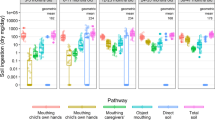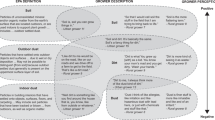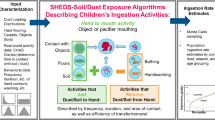Abstract
Soil and dust ingestion rates by children are among the most critical exposure factors in determining risks to children from exposures to environmental contaminants in soil and dust. We believe this is the first published soil ingestion study for children in Taiwan using tracer element methodology. In this study, 66 children under 3 years of age were enrolled from Taiwan. Three days of fecal samples and a 24-h duplicate food sample were collected. The soil and household dust samples were also collected from children’s homes. Soil ingestion rates were estimated based on silicon (Si) and titanium (Ti). The average soil ingestion rates were 9.6±19.2 mg/day based on Si as a tracer. The estimated soil ingestion rates based on Si did not have statistically significant differences by children’s age and gender, although the average soil ingestion rates clearly increased as a function of children’s age category. The estimated soil ingestion rates based on Si was significantly and positively correlated with the sum of indoor and outdoor hand-to-mouth frequency rates. The average soil ingestion rates based on Si were generally lower than the results from previous studies for the US children. Ti may not be a suitable tracer for estimating soil ingestion rates in Taiwan because the Ti dioxide is a common additive in food. To the best of our knowledge, this is the first study that investigated the correlations between soil ingestion rates and mouthing behaviors in Taiwan or other parts of Asia. It is also the first study that could compare available soil ingestion data from different countries and/or different cultures. The hand-to-mouth frequency and health habits are important to estimate the soil ingestion exposure for children. The results in this study are particularly important when assessing children’s exposure and potential health risk from nearby contaminated soils in Taiwan.
This is a preview of subscription content, access via your institution
Access options
Subscribe to this journal
Receive 6 print issues and online access
$259.00 per year
only $43.17 per issue
Buy this article
- Purchase on Springer Link
- Instant access to full article PDF
Prices may be subject to local taxes which are calculated during checkout

Similar content being viewed by others
References
Barnes RM . Childhood soil ingestion: how much dirt do kids eat? Anal Chem 1990; 62: 1023A–1026A 1030A-1033A.
Binder S, Sokal D, Maughan D . Estimating soil ingestion: the use of tracer elements in estimating the amount of soil ingested by young children. Arch Environ Health 1986; 41: 341–345.
Calabrese EJ, Barnes R, Stanek EJ, 3rd, Pastides H, Gilbert CE, Veneman P et al. How much soil do young children ingest: an epidemiologic study. Regul Toxicol Pharmacol 1989; 10: 123–137.
Calabrese EJ, Stanek EJ . An improved method for estimating soil ingestion in children and adults. J Environ Sci Heal A 1993; 28: 363–371.
Calabrese EJ, Stanek EJ, 3rd . Resolving intertracer inconsistencies in soil ingestion estimation. Environ Health Perspect 1995; 103: 454–457.
Calabrese EJ, Stanek EJ, 3rd, Barnes R . Soil ingestion rates in children identified by parental observation as likely high soil ingesters. Soil Sediment Contam 1997; 6: 271–279.
Calabrese EJ, Stanek EJ, 3rd, Pekow P, Barnes RM . Soil ingestion estimates for children residing on a superfund site. Ecotoxicol Environ Saf 1997; 36: 258–268.
Davis S, Mirick DK . Soil ingestion in children and adults in the same family. J Expo Sci Environ Epidemiol 2006; 16: 63–75.
Davis S, Waller P, Buschbom R, Ballou J, White P . Quantitative estimates of soil ingestion in normal children between the ages of 2 and 7 years: population-based estimates using aluminum, silicon, and titanium as soil tracer elements. Arch Environ Health 1990; 45: 112–122.
Stanek EJ, Calabrese EJ, Xu B . Meta-analysis of mass-balance studies of soil ingestion in children. Risk Anal 2012; 32: 433–447.
Stanek EJ, Xu B, Calabrese EJ . Equation reliability of soil ingestion estimates in mass-balance soil ingestion studies. Risk Anal 2012; 32: 448–463.
van Wijnen JH, Clausing P, Brunekreef B . Estimated soil ingestion by children. Environ Res 1990; 51: 147–162.
Wong MS . The Role of Environmental and Host Behavioural Factors in Determining Exposure to Infection with Ascaris Lumbricoldes and Trichuris Trichiura. PhD thesis. University of the West Indies: : Mona, Jamaica. 1988.
Hogan K, Marcus A, Smith R, White P . Integrated exposure uptake biokinetic model for lead in children: empirical comparisons with epidemiologic data. Environ Health Perspect 1998; 106 (Suppl 6): 1557–1567.
von Lindern I, Spalinger S, Petroysan V, von Braun M . Assessing remedial effectiveness through the blood lead: soil/dust lead relationship at the Bunker Hill Superfund Site in the Silver Valley of Idaho. Science Total Environ 2003; 303: 139–170.
Day JP, Hart M, Robinson MS . Lead in urban street dust. Nature 1975; 253: 343–345.
Duggan MJ, Williams S . Lead in dust in city streets. Sci Total Environ 1977; 7: 91–97.
Lepow ML, Bruckman L, Gillette M, Markowitz S, Robino R, Kapish J . Investigations into sources of lead in the environment of urban children. Environ Res 1975; 10: 415–426.
Lepow ML, Bruckman L, Rubino RA, Markowtiz S, Gillette M, Kapish J . Role of airborne lead in increased body burden of lead in Hartford children. Environ Health Perspect 1974; 7: 99–102.
Özkaynak H, Xue J, Zartarian VG, Glen G, Smith L . Modeled estimates of soil and dust ingestion rates for children. Risk Anal 2011; 31: 592–608.
Doyle JR, Blais JM, Holmes RD, White PA . A soil ingestion pilot study of a population following a traditional lifestyle typical of rural or wilderness areas. Sci Total Environ 2012; 424: 110–120.
Kuo CY, Wang JY, Liu WT, Lin PY, Tsai CT, Cheng MT . Evaluation of the vehicle contributions of metals to indoor environments. J Expo Sci Environ Epidemiol 2012; 22: 489–495.
Wu Y-S, Hung W-C . Heavy metal pollution in surface soils of five characteristic sampling sites in central Taiwan. Environ Forensics 2013; 14: 97–102.
Kuo CY, Chen HC, Cheng FC, Huang LR, Chien PS, Wang JY . Polycyclic aromatic hydrocarbons in household dust near diesel transport routes. Environ Geochem Health 2012; 34: 77–87.
Chao HR, Shy CG, Huang HL, Koh TW, Tok TS, Chen SCC et al. Particle-size dust concentrations of polybrominated diphenyl ethers (PBDEs) in southern Taiwanese houses and assessment of the PBDE daily intakes in toddlers and adults. Aerosol Air Qual Res 2014; 14: 1299–1309.
Tsou MC, Ozkaynak H, Beamer P, Dang W, Hsi HC, Jiang CB et al. Mouthing activity data for children aged 7 to 35 months in Taiwan. J Expo Sci Environ Epidemiol 2014; 25 (4): 388–398.
Moya J, Phillips L . A review of soil and dust ingestion studies for children. J Expo Sci Environ Epidemiol 2014; 24: 545–554.
Valentin J . Basic anatomical and physiological data for use in radiological protection: reference values: ICRP Publication 89. Annals ICRP 2002; 32: 1–277.
Doyle JR, White PA, Blais JM . A pilot study to assess the feasibility of using naturally-occurring radionuclides as mass balance tracers to estimate soil ingestion. Ecotoxicol Environ Saf 2012; 83: 34–40.
Weir A, Westerhoff P, Fabricius L, Hristovski K, von Goetz N . Titanium dioxide nanoparticles in food and personal care products. Environ Sci Technol 2012; 46: 2242–2250.
Adgate JL, Weisel C, Wang Y, Rhoads GG, Lioy PJ . Lead in house dust: relationships between exposure metrics. Environ Res 1995; 70: 134–147.
Johnson DL, Hunt A, Griffith DA, Hager JM, Brooks J, Stellalevinsohn H et al. Geographic patterns of non-carpeted floor dust loading in Syracuse, New York (USA) homes. Environ Geochem Health 2009; 31: 353–363.
Layton DW, Beamer PI . Migration of contaminated soil and airborne particulates to indoor dust. Environ Sci Technol 2009; 43: 8199–8205.
Moran RE, Bennett DH, Tancredi DJ, Wu X, Ritz B, Hertz-Picciotto I . Frequency and longitudinal trends of household care product use. Atmos Environ 2012; 55: 417–424.
Freeman NC, Ettinger A, Berry M, Rhoads G . Hygiene- and food-related behaviors associated with blood lead levels of young children from lead-contaminated homes. J Expo Anal Environ Epidemiol 1997; 7: 103–118.
Freeman NC, Jimenez M, Reed KJ, Gurunathan S, Edwards RD, Roy A et al. Quantitative analysis of children's microactivity patterns: the Minnesota Children's Pesticide Exposure Study. J Expo Anal Environ Epidemiol 2001; 11: 501–509.
Freeman NC, Sheldon L, Jimenez M, Melnyk L, Pellizzari E, Berry M . Contribution of children's activities to lead contamination of food. J Expo Anal Environ Epidemiol 2001; 11: 407–413.
ICRP. Age-dependent doses to the members of the public from intake of radionuclides - part 5 compilation of ingestion and inhalation coefficients. ICRP Publication 72, Ann ICRP 1996; 26 (1): 1–91.
Acknowledgements
This project was supported by the Taiwan Environmental Protection Administration (project no. EPA-100-G101-03-A036 and EPA-101-GA101-02-A143). This article was reviewed in accordance with the policy of the National Exposure Research Laboratory, US Environmental Protection Agency and approved for publication. Approval does not signify that the contents necessarily reflect the view and policies of the agency.
Author information
Authors and Affiliations
Corresponding author
Ethics declarations
Competing interests
The authors declare no conflict of interest.
Rights and permissions
About this article
Cite this article
Chien, LC., Tsou, MC., Hsi, HC. et al. Soil ingestion rates for children under 3 years old in Taiwan. J Expo Sci Environ Epidemiol 27, 33–40 (2017). https://doi.org/10.1038/jes.2015.61
Received:
Revised:
Accepted:
Published:
Issue Date:
DOI: https://doi.org/10.1038/jes.2015.61
Keywords
This article is cited by
-
A systematic characterization of soil/dust ingestion for typical subpopulations in China
Environmental Geochemistry and Health (2023)
-
Model based prediction of age-specific soil and dust ingestion rates for children
Journal of Exposure Science & Environmental Epidemiology (2022)
-
Soil ingestion among young children in rural Bangladesh
Journal of Exposure Science & Environmental Epidemiology (2021)



